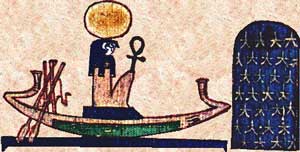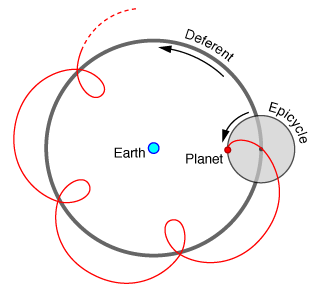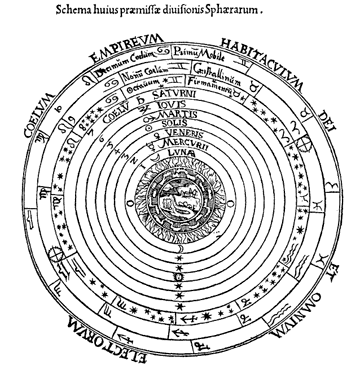
A depiction of Ra, the ancient Egyptian sun god, in the boat that carried him across the heavens. (Wikimedia Commons.)
There are three good reasons to study the history of astronomy. First, history itself is fascinating. Second, you'll understand the facts of astronomy better if you know a little about why astronomers came to believe such incredible things. And third, the history of once-controversial ideas can shed light on scientific controversies that are still alive today.
This chapter begins the story of the greatest scientific controversy of all time: the battle over earth's place in the universe. Is the earth unique, occupying a special place at the center of the universe? Or is it just another planet, drifting through space like the rest of the heavenly bodies? Today, every school child is taught that the second view is correct. But only a few hundred years ago, this view was considered absurd and even blasphemous. Let's try to understand why.
To our senses, the distinction between the heavens and the earth is totally obvious. The heavens are full of luminous objects in eternal motion, while the earth is a dark mass of rock and water where nothing keeps moving for very long. Everyone can see that the earth doesn't move, while the motions of water and wind seem to be caused by influences from above. Even humans and animals, which can put themselves into motion at will, eventually die and decay. Because heavenly motions never cease, and the heavenly lights never burn out, the heavens must be supernatural—populated by immortal deities.

A depiction of Ra, the ancient Egyptian sun god, in the boat that carried him across the heavens. (Wikimedia Commons.)
Long before the invention of writing, different cultures developed different stories about the heavenly deities. The sun was often the most important of the gods, while other gods were associated with the moon, planets, and stars. Our modern names for the planets, and for many of the constellations, are based on the particular mythologies that developed in and around ancient Greece.
But eventually, as described in earlier chapters, the Greeks realized that the heavenly motions are far too regular and repetitive to be attributed to the whims of the gods. Instead, Greek thinkers began devising mechanical models to explain these motions: giant wheels or spheres, carrying the celestial bodies around us in grand circles. By the time of Plato and Aristotle, the consensus view among educated Greeks was the Two-Sphere Model of the universe (as Thomas Kuhn later called it): A spherical earth, fixed at the center of the universe, surrounded by an enormous celestial sphere, holding the stars and spinning around us once a day. The sun, moon, and planets were presumably somewhere in between, carried around in their circles by similar mechanisms.
This system became complicated, however, when the Greeks tried to account for the motions of the planets in a quantitative way. Especially problematic were the periodic reversals in the plantets' motions, from forward to retrograde and back again. Even the sun and the moon seem to move at slightly different speeds at different times, complicating predictions of their rising and setting times—not to mention eclipses. Quite a few Greek thinkers were curious about these complexities. Also, astronomers who could make accurate predictions found that they could sell their services in the form of astrological horoscopes.

In the ancient Greek epicycle model of planetary motion, each planet is affixed to a small wheel (the "epicycle") whose center is affixed to a large wheel (the "deferent"). The simultaneous motion of the epicycle and deferent causes the planet to follow a loop-de-loop path, shown in red.
Greek astronomers devised many mechanisms to account for the irregularities of planetary motion. Among these mechanisms, the most famous is the deferent-epicycle system, shown in the illustration at right. In this model, each planet is carried around us by a combination of two invisible wheels. The larger wheel, called the "deferent", is centered on the earth (at least approximately) and accounts for the planet's forward motion. But instead of being attached directly to the deferent, the planet is attached to the rim of a smaller wheel, the "epicycle", whose center is attached to the deferent. The planet's actual path, therefore, makes loop-de-loops around the deferent as each wheel turns at its own rate. From earth's perspective, the planet moves in the "forward" direction most of the time, but reverses to undergo retrograde motion during the innermost part of each loop.
To better understand the deferent-epicycle system, I highly recommend that you spend some time with the Ptolemaic System Simulator, a web applet created by the Nebraska Astronomy Applet Project. Notice how you can adjust the epicycle's size and turning rate to produce a wide variety of looping planetary motions. A handy menu adjusts the settings to model the motion of Venus, Mars, Jupiter, or Saturn.
The basic deferent-epicycle model can account for the forward and retrograde motion of the planets. But to match the observed planetary motions in quantitative detail, ancient Greek astronomers had to introduce further complications: off-setting the earth from the center of the deferent; varying the rate at which the deferent turns during its rotation; and so on. This effort culminated in the work of Ptolemy, an astronomer who lived in Alexandria during the second century A.D. His astronomical treatise, known today by its Arabic title Almagest, became the authoritative reference on the subject throughout the Arab world and Europe for the next 1400 years. Although the calculations were complex, astronomers could use the system of Ptolemy's Almagest to predict planetary positions with reasonable accuracy.
[Insert exercises based on Ptolemaic simulation]
Let's face it: Most people couldn't care less about the technical details of planetary motion. Let the experts do their calculations however they like! But most of us do care about the Big Picture: the overall shape of the universe, the relationship of the earth to the heavens, and the reasons why these things are the way they are. The study of these grand matters is called cosmology.

This illustration from Peter Apian's Cosmographia (first published in 1524) shows a typical medieval view of cosmology. At the center of the universe is the earth, surrounded by layers of water, air, and fire. Then come the spheres of the moon, sun, planets, and stars. Finally, surrounding the universe, is the Empyrean Heaven, dwelling place of God. (Wikimedia Commons.)
Whether we like it or not, the technical details of astronomy have influenced cosmology since the time of the ancient Greeks. The basic two-sphere model (with additional circles or spheres for those who cared about planetary details) became the dominant cosmological model throughout the ancient Mediterranean and beyond. During the Middle Ages, Islamic and Christian scholars adopted this cosmology and incorporated it into their writings with only minor modifications. (One important addition was the placement of Heaven, the home of God and angels, just beyond the sphere of the stars.) This world-view made its way into important literature such as Dante's Divine Comedy.
Cosmology doesn't stop with the geometrical arrangement of earth and heavens; it also includes explanations. Aristotle and other ancient Greeks explained our physical surroundings in terms of a small number of elements such as earth, water, air, and fire. Everyday objects are supposedly made of various mixtures of these elements. Those containing mostly earth possess "gravity", a natural tendency to sink toward the center of the universe. Water has less gravity than earth, while air and fire have a natural tendency to rise (which we might call "levity"). All the elements seek their natural places, in concentric shells around the center, where they remain unless disturbed. The heavens, on the other hand, naturally turn in eternal circles and so must be made of some other material, called aether. Besides its eternal motion, aether can be luminous, causing the heavenly bodies to shine by their own light.
Christian thinkers modified the Aristotelian view somewhat, making it less mechanical and more dependent on angels, for instance, to keep the heavenly motions going. Still, earth retained its natural place as the central focus of creation, with the drama of our lives caused by the tension between earthly and heavenly influences.
Copyright ©2010-2011 Daniel V. Schroeder. Some rights reserved.